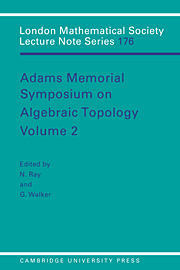Book contents
- Frontmatter
- Contents
- Preface
- Contents of Volume 1
- Programme of one-hour invited lectures
- Programme of contributed lectures
- Programme of Posters
- Participants in the Symposium
- Addresses of Contributors
- 1 Progress report on the telescope conjecture
- 2 On K*-local stable homotopy theory
- 3 Detruncating Morava K-theory
- 4 On the p-adic interpolation of stable homotopy groups
- 5 Some remarks on υ1 -periodic homotopy groups
- 6 The unstable Novikov spectral sequence for Sp(n), and the power series sinh−1(x)
- 7 Unstable Adams spectral sequence charts
- 8 On a certain localization of the stable homotopy of the space XΓ
- 9 Cooperations in elliptic homology
- 10 Completions of G-spectra at ideals of the Burnside ring
- 11 Theorems of Poisson, Euler and Bernouilli on the Adams spectral sequence
- 12 Algebras over the Steenrod algebra and finite H-spaces
- 13 The boundedness conjecture for the action of the Steenrod algebra on polynomials
- 14 Representations of the homology of BV and the Steenrod algebra I
- 15 Generic representation theory and Lannes' T-functor
- 16 Some chromatic phenomena in the homotopy of MSp
- 17 On a conjecture of Mahowald concerning bordism with singularities
- 18 Topological gravity and algebraic topology
2 - On K*-local stable homotopy theory
Published online by Cambridge University Press: 18 January 2010
- Frontmatter
- Contents
- Preface
- Contents of Volume 1
- Programme of one-hour invited lectures
- Programme of contributed lectures
- Programme of Posters
- Participants in the Symposium
- Addresses of Contributors
- 1 Progress report on the telescope conjecture
- 2 On K*-local stable homotopy theory
- 3 Detruncating Morava K-theory
- 4 On the p-adic interpolation of stable homotopy groups
- 5 Some remarks on υ1 -periodic homotopy groups
- 6 The unstable Novikov spectral sequence for Sp(n), and the power series sinh−1(x)
- 7 Unstable Adams spectral sequence charts
- 8 On a certain localization of the stable homotopy of the space XΓ
- 9 Cooperations in elliptic homology
- 10 Completions of G-spectra at ideals of the Burnside ring
- 11 Theorems of Poisson, Euler and Bernouilli on the Adams spectral sequence
- 12 Algebras over the Steenrod algebra and finite H-spaces
- 13 The boundedness conjecture for the action of the Steenrod algebra on polynomials
- 14 Representations of the homology of BV and the Steenrod algebra I
- 15 Generic representation theory and Lannes' T-functor
- 16 Some chromatic phenomena in the homotopy of MSp
- 17 On a conjecture of Mahowald concerning bordism with singularities
- 18 Topological gravity and algebraic topology
Summary
Introduction
Many of the hidden features of stable homotopy theory can be conveniently exposed by localizing the stable homotopy category with respect to appropriate homology theories. In this note we discuss the algebraic structure of K*-local stable homotopy theory, where K* is the usual complex K-homology theory. We work integrally, not just at a prime. Our main goal is to give a homotopy classification of the K*-local spectra, using a united K-homology theory which combines the complex, real, and self-conjugate theories. As an interesting byproduct of this work, we also obtain a Kunneth theorem for the united K-homology of a smash product of spectra or a product of spaces. Full technical details will appear in [9] and elsewhere.
We work in the stable homotopy category S of CW-spectra and begin by recalling the general theory of homological localizations of spectra for a homology theory E* determined by a spectrum E (see [2], [7], [11]). To expose the part of stable homotopy theory seen by E*, we may use the category of fractions S [ε–l] obtained from S by adjoining formal inverses to the E*-equivalences. However, to be more concrete and to avoid set theoretic difficulties, we call a spectrum Y E*-local if each E*-equivalence V → W of spectra induces an isomorphism [W, Y]* ≅ [v, Y]*, and we call a map X → XE of spectra an E*-localization if it is an E *-equivalence with XE E*-local.
- Type
- Chapter
- Information
- Adams Memorial Symposium on Algebraic Topology , pp. 23 - 34Publisher: Cambridge University PressPrint publication year: 1992
- 1
- Cited by



